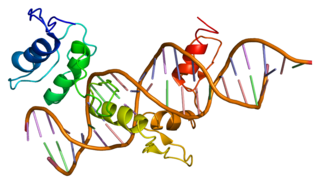
Bert Vogelstein is director of the Ludwig Center, Clayton Professor of Oncology and Pathology and a Howard Hughes Medical Institute investigator at The Johns Hopkins Medical School and Sidney Kimmel Comprehensive Cancer Center. A pioneer in the field of cancer genomics, his studies on colorectal cancers revealed that they result from the sequential accumulation of mutations in oncogenes and tumor suppressor genes. These studies now form the paradigm for modern cancer research and provided the basis for the notion of the somatic evolution of cancer.

Zinc finger protein GLI1 also known as glioma-associated oncogene is a protein that in humans is encoded by the GLI1 gene. It was originally isolated from human glioblastoma cells.

Probable G-protein coupled receptor 124 is a protein that in humans is encoded by the GPR124 gene. It is a member of the adhesion-GPCR family of receptors. Family members are characterized by an extended extracellular region with a variable number of protein domains coupled to a TM7 domain via a domain known as the GPCR-Autoproteolysis INducing (GAIN) domain.

Adhesion G-protein coupled receptor A3 (ADGRA3), also known as GPR125, is an adhesion GPCR that in humans is encoded by the Adgra3 gene.

Semaphorin-4D (SEMA4D) also known as Cluster of Differentiation 100 (CD100), is a protein of the semaphorin family that in humans is encoded by the SEMA4D gene.

Anthrax toxin receptor 1 is a protein that in humans is encoded by the ANTXR1 gene. Its molecular weight is predicted as about 63kDa.

Lipopolysaccharide-induced tumor necrosis factor-alpha factor is a protein that in humans is encoded by the LITAF gene.

Colorectal mutant cancer protein is a protein that in humans is encoded by the MCC gene.

Plexin-A1 is a protein that in humans is encoded by the PLXNA1 gene.

Putative quinone oxidoreductase is an enzyme that in humans is encoded by the TP53I3 gene.

Carboxypeptidase A1 is an enzyme that in humans is encoded by the CPA1 gene.

GTP-binding protein Rhes is a protein that in humans is encoded by the RASD2 gene.

Endosialin is a protein that in humans is encoded by the CD248 gene.

Tumor protein p53-inducible protein 11 is a protein that in humans is encoded by the TP53I11 gene.

Plexin-D1 is a protein that in humans is encoded by the PLXND1 gene.

BTB/POZ domain-containing protein TNFAIP1 is a protein that in humans is encoded by the TNFAIP1 gene.

Etoposide-induced protein 2.4 homolog is a protein that in humans is encoded by the EI24 gene.

Krueppel-related zinc finger protein 1 is a protein that in humans is encoded by the HKR1 gene.

Endothelial zinc finger protein induced by tumor necrosis factor alpha is a protein that in humans is encoded by the ZNF71 gene.

Plexin domain-containing protein 2 is a protein that in humans is encoded by the PLXDC2 gene.





















